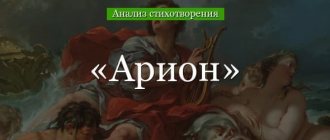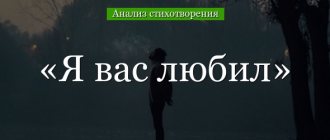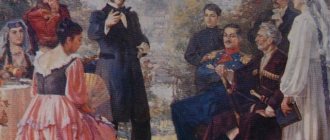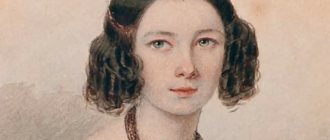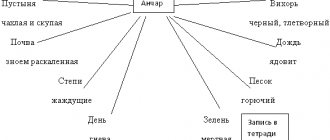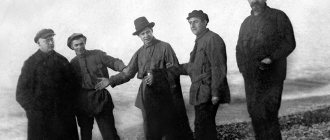“Oh Muse! I'm at the door of the coffin! Nekrasov
“Oh Muse!
I'm at the door of the coffin! analysis of the work - theme, idea, genre, plot, composition, characters, issues and other issues are discussed in this article.
History of creation
The poem “O Muse! I'm at the door of the coffin! "Written in 1877. It is considered Nekrasov’s last poem, according to the recollections of his sister. A poem is the result of a writer’s life and poetic testament. It was published in “Notes of the Fatherland” No. 1 for 1878.
In the last years of his life, the writer was seriously ill. Feeling his imminent death, he turns to his favorite image of poetry - the Muse.
Literary direction and genre
The poem must be considered in the context of Nekrasov’s entire work as a realist poet. It plays the same role in Nekrasov’s work as the poem “Monument” in Pushkin’s work, as well as other monument poems (Horace, Derzhavin). In the poem “O Muse!..” Nekrasov draws a conclusion about the role of the poet and poetry, about the significance of his own poetry in the life of society. The poem belongs to the genre of civil lyrics.
Theme, main idea and composition
The poem consists of three stanzas. Nekrasov does not separate them with spaces, and they are inseparable from one another, because neither the first nor the second stanza ends the sentence, which continues in the next stanza. This technique makes the monologue continuous. The lyrical hero seems to be in a hurry to say everything to the end, to have time to speak out.
The poem can be divided into three semantic passages. In the first, the lyrical hero repents before the Muse, an allegory of the poet’s work. In the second part, the lyrical hero encourages his Muse, connects himself with her, associating his creativity with the source of this creativity.
In the third part, Nekrasov describes the Muse. He contrasts the attitude towards the Muse (creativity) of Russian and non-Russian consciousness. The themes raised by the revolutionary democrat Nekrasov in his work are uninteresting and unsympathetic for a foreigner: people's life along with all its suffering.
The theme of the poem “O Muse!..” is popular recognition of the poet’s work.
Main idea: Nekrasov’s muse is close to the Russian people.
Paths and images
The image of the Muse is the leitmotif of Nekrasov’s work. In the poem “Yesterday, at about six o’clock,” the lyrical hero calls Muse the sister of a young peasant woman who silently endures the beating with a whip. Even in his youth, Nekrasov determined the priorities of his work: closeness to the people and willingness to endure suffering (Nekrasov suffered a lot from the censors). The image of the Muse also appears in other poems of the poet. In one of his later works, Nekrasov speaks of Muse: “The sister of the people is also mine.” The last poem sums up the poet's poetic activity. Anyone who does not understand the Russian people (not Russian) is far from the topic of people’s suffering, and therefore does not like “ pale, covered in blood, cut with a whip.”
Muse." Epithets describing the Muse are metaphorical characteristics of creativity.
But honest hearts are united with a living, blood-borne
a union (epithets) that will not break for a long time. That is, the writer will be interesting to his people for a long time. This is a roll call with Pushkin: “And for a long time I will be so kind to the people.”
Blood epithet
refers to a quote from another poem about the role of the poet and poetry: “A thing is strong when blood flows underneath it” (“Poet and Citizen”). A blood union is a union of like-minded people engaged in one noble cause.
The poem begins with an appeal to the Muse and metaphorical poetry " at the door of the coffin."
Expecting death, the lyrical hero repents before the Muse. Nekrasov saw the poet's purpose as serving the people. He asks for forgiveness, obviously, for the compromises that had to be made with censorship, or for the departure from folk themes in his work.
Nekrasov knew that he had many ill-wishers. He encountered them both as a poet and as the editor of Sovremennik, which was, after all, closed. He conveys this idea using a metaphor: human anger will increase his guilt “a hundredfold.”
The lyrical hero asks the Muse not to cry. He does not separate himself and his creativity. The fate of both the poet and his poems is enviable: “They will not mock us.” The poet will be held in high esteem as long as there are hearts to which his poems are close. On the verge of death, Nekrasov affirms his life’s work: to convey to the Russian people the ideals of truth and humanism.
Meter and rhyme
The poem is written in iambic tetrameter. Women's rhyme alternates with men's. The rhyme is circular.
O Muse! I'm at the door of the coffin! Let me be guilty a lot, Let human anger increase my guilt a hundredfold - Don’t cry! Our lot is enviable, They will not scoff at us: Between me and honest hearts You will not let the living, blood union break for a long time! Not Russian - he will look without love
To this pale Muse, covered in blood, cut by the Whip...
Brief Analysis
Before reading this analysis, we recommend that you familiarize yourself with the poem Muse.
History of creation - the work appeared in 1829, it was first published in 1835 on the pages of Sovremennik.
The theme of the poem is the muse, inspiring in its simplicity.
Composition - The poem is a monologue-description of the muse. In terms of meaning, it cannot be divided into parts, because the lines of the work gradually reveal the main quality of the muse - its majestic simplicity.
Genre : elegy.
The meter of the poem is iambic pentameter, the rhyme pattern is cross ABAB and parallel AABB.
Metaphors - “I am not blinded by my muse”, “they will not run away from a crowd in love”, “a trick of the eyes”, “I am amazed by a glimpse of light”.
Epithets - “brilliant conversation”, “calm simplicity”, “caustic condemnation”, “careless praise”.
“Muse” N. Nekrasov
Text of the poem “Muse” Nikolai Nekrasov
No, the Muse singing tenderly and beautifully I don’t remember the sweet-voiced song above me! In heavenly beauty, inaudibly, like a spirit, Flying from on high, my infant ear, She did not teach me magic harmony, In my swaddling clothes I did not forget the flute, In the midst of my amusements and adolescent thoughts, I did not disturb my mind with an obscure dream, And did not suddenly appear to the rapturous gaze of a loving friend in that blissful time, When our blood is languidly agitated by the inseparable Muse and Love...
But early on I was burdened by the bonds of Another, unkind and unloved Muse, The sad companion of the sad poor, Born for labor, suffering and fetters, - That Muse crying, grieving and hurting, Always thirsty, humbly asking, For whom gold is the only idol... To the delight of the new a stranger in God's world, In a wretched hut, in front of a smoky ray, Bent over with labor, killed by the torment, She sang to me - and her simple melody was full of melancholy and eternal complaint. It happened that, unable to bear the tormenting grief, she suddenly cried, echoing my sobs, or disturbed my infant sleep with a riotous song... But the same mournful moan sounded even more shrill in the noisy revelry.
Everything was heard in him in a crazy confusion: Calculations of petty and dirty vanity, And beautiful dreams of youth, Lost love, suppressed tears, Curses, complaints, powerless threats. In a fit of rage, with human untruth, the Madwoman vowed to start a stubborn battle. Indulging in wild and gloomy fun, She played madly with my cradle, Shouting: vengeance! and with a violent tongue she called the Lord's thunder upon the heads of the enemies!
In an embittered, but loving and tender soul, the impulse of rebellious cruelty was fragile. Slowly weakening, the tormenting illness was humbled, subsided... and suddenly the whole riot of wild passions and fierce sorrow was redeemed in one divinely beautiful minute, when the sufferer, bowing her head, “Farewell to your enemies!” whispered above me...
So the ever-crying and incomprehensible maiden cherished the harsh melodies of my ears, Until finally, in the usual sequence, I entered into a fierce battle with her. But since childhood, the Muse was in no hurry to break a strong and blood union with me: Through the dark abysses of Violence and Evil, Labor and Hunger, she led me - She taught me to feel my suffering and blessed me to announce them to the world...
1852
Analysis of Nekrasov’s poem “Muse”
Nekrasov is considered one of the most prominent Russian realist poets, whose work conveys without embellishment the events that the author happened to witness. In addition, Nekrasov is often called the singer of the peasants, since most of his works were dedicated to the life and everyday life of the lower classes of society.
Nekrasov was quite self-critical and assessed his works from the point of view of the benefits they could bring to society. Therefore, he often admitted that he was a useless poet - his poems were not able to awaken people, force them to act and change something in their lives. Of course, the author did not take into account the fact that most of the messages in his work are addressed to those very peasants who simply do not know how to read. As for the Russian intelligentsia, the times of Pushkin, when one rhymed quatrain could make them take up arms and organize the Decembrist uprising, are in the distant past.
Assessing his creativity, Nikolai Nekrasov wrote the poem “Muse” in 1852, in which he tried to explain what exactly inspires him to create poetic works . From the first lines of the poem, it becomes clear that Nekrasov’s muse is not an ephemeral young lady who makes the heart beat stronger and feel the beautiful more keenly. “I don’t remember a sweet-voiced song over me!” notes the author, hinting at his joyless childhood and very difficult youth, when without a livelihood he was forced to run away from home from his tyrant father. However, even in later years, “the inseparable Muse and Love” did not appear to the poet.
Having experienced all the difficulties of a beggarly existence, the poet notes that too early he was “burdened by the bonds” of a completely different “unkind and unloved Muse,” who opened the poet’s eyes to real life, devoid of secular gloss and good manners. The image of “that Muse, crying, grieving and paining,” for whom material wealth is “the only idol,” haunted Nekrasov all his life, not allowing him to forget for a moment what he saw in the St. Petersburg slums and Russian villages, similar to each other. friend in his poverty, like twin brothers.
According to the poet, the muse taught him to hate . with her help, he learned the thirst for revenge and too soon forgot about his youthful dreams, beautiful and ambitious. The muse sang “raunchy songs” to him, putting them into the mouths of drunken men, “her simple tune” was more like a groan or an endless complaint. Sometimes the poet’s muse indulged in “wild and gloomy fun,” calling on the author to “start a stubborn battle” and offering him help from “the Lord’s thunder,” which was supposed to fall on the heads of those who flooded Russia with blood and tears.
But such impulses were infrequent and short-lived. The exhausted muse, which the author associates with the Russian people, enslaved and powerless, very soon, “hanging her head,” whispered to the poet a request to forgive his enemies. This primordial Slavic humility, which Nekrasov encountered from childhood, perhaps made the greatest impression on the poet. Until his death, he tried to unravel this absurd and illogical riddle of the Russian soul, not understanding why tens of thousands of people so resignedly and wordlessly allow themselves to be bullied by a handful of landowners, whom it is not difficult to deal with if desired.
At the same time, the poet admits that he himself did not dare to contradict the muse . which often simply silently led him “through the dark abyss of Violence and Evil.” And it was the muse, or, more precisely, the Russian people, who taught Nekrasov to “feel his suffering” and “blessed him to announce it to the world.”
History of creation
E. Baratynsky wrote the analyzed work in 1829. By this time, the poet had already published three poems and released a collection of poetry. Creative achievements pushed him to reflect on the essence of poetic creativity. During the era of Baratynsky, many poems dedicated to the muse appeared in Russian literature. Evgeniy Abramovich also believed in the divine principle of poetry, but his muse differs from the “inspiration” of other poets.
Contemporary poets of Baratynsky created images of goddesses of art under the impression of the beauty of their beloved women. Researchers of Yevgeny Abramovich’s work argue that his muse is a prototype of spiritual impulses, not a woman. Although a parallel can be drawn between the muse and the poet’s wife. It is known that his wife Anastasia was not distinguished by beauty, but had an extraordinary mind and good taste.
The poem was first seen by the world only 6 years after it was written. In 1835 it was published in Sovremennik.
Genre, size, direction
The Romantic era viewed the ability to create works of art, in particular to write poetry, as a gift from above. The poet was perceived as a conductor between the human world and the divine. At that time, it was believed that creation was the fruit of inspiration given by the muses. And this tradition dates back to antiquity. Many authors of the Pushkin era tried to describe the act of creativity, and among such “explanations” is the work of E. Baratynsky.
In terms of genre, “Muse” is closest to a lyric poem, which involves a sketch, a poetic statement of a small volume. The poetic meter is iambic.
Subject
In the poem, the poet explored the theme of a muse that gives inspiration. In the context of it, the motive of the divine principle of poetic art develops. The main theme determined the system of images of the work: the lyrical hero, the muse and society (light). The latter is a minor character.
Already in the first verses, the lyrical hero declares that his muse is not at all beautiful. She does not make young men fall in love with her, does not flirt and does not amaze with filigree speeches. However, it is clear that the hero loves his inspiration. What attracts him?
The fact is that his muse “glimpsingly” amazes with a facial expression that stands out from a number of other expressions. Simplicity and calmness add charm to her speeches. These qualities deserve the praise of society. The lyrical hero is sure that his muse will not be condemned.
In the work, E. Baratynsky realized the idea that the essence of poetic creativity is in simplicity and thoughts that make the reader think about eternal questions.
Analysis “O Muse! I'm at the door of the coffin! Nekrasov
Analysis
“Oh Muse! I'm at the door of the coffin! Nekrasov
“Oh Muse! I'm at the door of the coffin! analysis of the work - theme, idea, genre, plot, composition, characters, issues and other issues are discussed in this article.
History of creation
The poem “O Muse! I'm at the door of the coffin! written in 1877. It is considered Nekrasov’s last poem, according to the recollections of his sister. A poem is the result of a writer’s life and poetic testament. It was published in “Notes of the Fatherland” No. 1 for 1878.
In the last years of his life, the writer was seriously ill. Feeling his imminent death, he turns to his favorite image of poetry - the Muse.
Literary direction and genre
The poem must be considered in the context of Nekrasov’s entire work as a realist poet. It plays the same role in Nekrasov’s work as the poem “Monument” in Pushkin’s work, as well as other monument poems (Horace, Derzhavin). In the poem “O Muse!..” Nekrasov draws a conclusion about the role of the poet and poetry, about the significance of his own poetry in the life of society. The poem belongs to the genre of civil lyrics.
Theme, main idea and composition
The poem consists of three stanzas. Nekrasov does not separate them with spaces, and they are inseparable from one another, because neither the first nor the second stanza ends the sentence, which continues in the next stanza. This technique makes the monologue continuous. The lyrical hero seems to be in a hurry to say everything to the end, to have time to speak out.
The poem can be divided into three semantic passages. In the first, the lyrical hero repents before the Muse, an allegory of the poet’s work. In the second part, the lyrical hero encourages his Muse, connects himself with her, associating his creativity with the source of this creativity.
In the third part, Nekrasov describes the Muse. He contrasts the attitude towards the Muse (creativity) of Russian and non-Russian consciousness. The themes raised by the revolutionary democrat Nekrasov in his work are uninteresting and unsympathetic for a foreigner: people's life along with all its suffering.
The theme of the poem “O Muse!..” is popular recognition of the poet’s work.
Main idea: Nekrasov’s muse is close to the Russian people.
Paths and images
The image of the Muse is the leitmotif of Nekrasov’s work. In the poem “Yesterday, at about six o’clock,” the lyrical hero calls Muse the sister of a young peasant woman who silently endures the beating with a whip. Even in his youth, Nekrasov determined the priorities of his work: closeness to the people and willingness to endure suffering (Nekrasov suffered a lot from the censors). The image of the Muse also appears in other poems of the poet. In one of his later works, Nekrasov speaks of Muse: “The sister of the people is also mine.” The last poem sums up the poet's poetic activity. Anyone who does not understand the Russian people (not Russian) is far from the topic of people's suffering, and therefore does not love the “pale, bloody, whip-cut Muse.” Epithets describing the Muse are metaphorical characteristics of creativity.
But honest hearts are united with the poet by a living, blood union (epithets), which will not break for a long time. That is, the writer will be interesting to his people for a long time. This is a roll call with Pushkin: “And for a long time I will be so kind to the people.”
The epithet blood refers to a quote from another poem about the role of the poet and poetry: “A thing is strong when blood flows underneath it” (“Poet and Citizen”). A blood union is a union of like-minded people engaged in one noble cause.
The poem begins with an appeal to the Muse and metaphorical poetry "at the door of the coffin." Expecting death, the lyrical hero repents before the Muse. Nekrasov saw the poet's purpose as serving the people. He asks for forgiveness, obviously, for the compromises that had to be made with censorship, or for the departure from folk themes in his work.
Nekrasov knew that he had many ill-wishers. He encountered them both as a poet and as the editor of Sovremennik, which was, after all, closed. He conveys this idea using a metaphor: human anger will increase his guilt “a hundredfold.”
The lyrical hero asks the Muse not to cry. He does not separate himself and his creativity. The fate of both the poet and his poems is enviable: “They will not mock us.” The poet will be held in high esteem as long as there are hearts to which his poems are close. On the verge of death, Nekrasov affirms his life’s work: to convey to the Russian people the ideals of truth and humanism.
Meter and rhyme
The poem is written in iambic tetrameter. Women's rhyme alternates with men's. The rhyme is circular.
Means of expression
In order to reveal the theme and create the image of a muse. The text contains metaphors - “I am not blinded by my muse”, “they will not run away from a crowd in love”, “a play of the eyes”, “I am amazed by a glimpse of light”; epithets - “brilliant conversation”, “calm simplicity”, “caustic condemnation”, “careless praise”.
Previous
Analysis of the poems “Don’t let your soul be lazy” analysis of Zabolotsky’s poem according to the plan briefly - topic, year, idea
Next
Analysis of the poem “Juniper Bush” analysis of Zabolotsky’s poem according to plan briefly - theme, idea, history of creation
Images and symbols
- The poem presents the image of a modest, unremarkable muse . The poet, inventing his character, proceeds from the opposite, repeatedly turning to negations. By the time this lyrical poem was written, the traditional image of the inspiration had already taken shape. But Baratynsky insists that the muse can be different: without inclinations, gifts and indescribable beauty. However, even such a servant of Apollo “is struck by a glimpse of light.”
- Light here denotes society, the reading public, to which the author’s work is aimed. Any poet needs recognition, but most often they try to achieve it through something pompous and grandiose. Baratynsky's lyrical hero, on the contrary, is simple, almost mediocre. And yet he achieves his goal.
- Muse is a symbol of creativity . Without it, as was believed in the 19th century, it is impossible to create anything at all. Words will not come to mind, and the pen will fall out of your hand.
